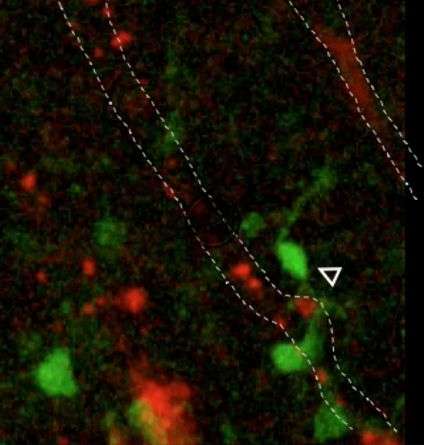Myelin cells swing along blood vessels to traverse the brain

The cells that create myelin, a fatty material that insulates nerve fibers in the brain's white matter, migrate into the developing brain by climbing and swinging on blood vessels, according to new research led by UC San Francisco scientists. The researchers also discovered a mechanism that coordinates when these immature cells – called oligodendrocyte precursors – hop off the vessels and differentiate into mature oligodendrocytes, wrapping themselves around nerve fibers to speed nerve transmission.
This novel developmental mechanism—described online Jan. 21, in the journal Science—could help researchers understand both the evolution of the highly myelinated human brain and also lead to advances in treating diseases of the myelin, such as multiple sclerosis.
"Humans have high amounts of myelinated nerve fibers relative to the size of our brains," said lead author Stephen Fancy, PhD, DVM, an assistant professor of pediatrics and neurology in UCSF's School of Medicine. "This is one of the things that makes us human, but how these cells migrate into the brain has been an open question in the field for decades. It's really tight quarters in there, and the substrate they use to get around has been very elusive."
The discovery came fortuitously when Fancy and his team were studying how oligodendrocyte precursor cells (OPCs) differentiate into their mature form. Previous research had shown that the Wnt signaling pathway inhibits this transformation until cells are in the right place to form myelin, but the team noticed that when they locked in high Wnt levels in mice, the precursor cells had problems migrating and appeared to become stuck to blood vessels.
"They were just clustered on the vessels like bunches of grapes, and that really piqued our interest," Fancy said. "It suddenly suggested to us that the precursors had been using the vessels to get around and we'd stuck them there, prevented them from getting off."
To confirm their hypothesis, the team conducted live imaging of migrating OPCs in the developing brains of mice and observed the cells crawling along vessels and extending arm-like extensions to jump from one vessel to another. (See video) The same process appears to occur in human brains as well, the researchers found, based on analysis of donated brain tissue from the UCSF Pediatric Neuropathology Research Laboratory, which revealed OPCs caught in the act of clambering and swinging on blood vessels.
"These cells appear to be using the blood vessels as a jungle gym, which could help explain their hugely rapid migration into the cortex during development," Fancy said.
The researchers showed that when a mouse's brain is unable to build blood vessels, precursor migration grinds to a halt. They also demonstrated that when the Wnt signaling pathway is blocked, it causes the precursor cells to fall off the vasculature throughout the brain, which seems to indicate that Wnt signaling normally keeps the cells associated with blood vessels during migration.
"It seems like Wnt signalling plays a dual role to coordinate the timing of migration and differentiation," Fancy said. "First it holds them in their immature form as they travel along the blood vessels, and then when they reach their destination it turns itself off to let them off their climbing frame and begin maturing."
Helping The Brain Fight Multiple Sclerosis
Fancy is eager to use these new insights to understand how to improve the lot of those suffering from multiple sclerosis and other disorders.
Multiple sclerosis occurs when the immune system attacks and kills myelin-forming oligodendrocytes, impeding nerve transmission and causing a variety of symptoms, including vision loss, numbness, muscle weakness and spasticity, mood swings, and cognitive decline. Patients often go through through cycles of relapse and recovery as the brain attempts to repair itself by replacing damaged myelin as fast as the immune system destroys it.
Fancy suspects that understanding how to help oligodendrocytes migrate to the location of myelin damage has the potential to significantly reduce the severity of relapses suffered by multiple sclerosis patients.
"There are a number of drugs now that can help reduce the initial demyelination in MS, but there is currently no therapy to aid remyelination," Fancy said. "This is one of those cases where by making discoveries about brain development, we stand to learn a lot about disease as well."
More information: H.-H. Tsai et al. Oligodendrocyte precursors migrate along vasculature in the developing nervous system, Science (2016). DOI: 10.1126/science.aad3839


















